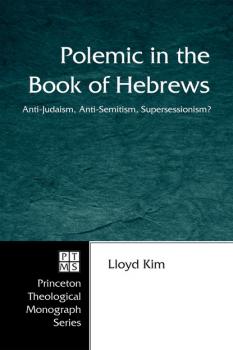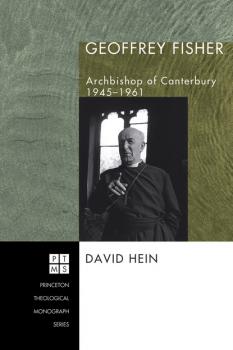ТОП просматриваемых книг сайта:
Princeton Theological Monograph Series
Скачать книги из серии Princeton Theological Monograph SeriesАннотация
"The author of Hebrews is arguing that God himself has brought about the fulfillment of these institutions through his Son's priesthood, his once-for-all sacrifice, and the new covenant he inaugurated in the last days. These new institutions are never denied the Jews. In fact, the context of the epistle presumes that these are primarily for the Jews, considering that the author was speaking to a Jewish-Christian community. The author is not arguing for the abandonment by God of the Jewish people, but rather for the abandonment of the shadowy means by which God's people drew near to him. It is here we can speak of a qualified supersessionism. According to the author of Hebrews, the Levitical priesthood, the Mosaic covenant, and the Levitical sacrifices have been superseded by Jesus' priesthood, the new covenant, and Jesus' once-for-all sacrifice. "However, we conclude that the polemical passages in Hebrews do not promote hatred of the Jews, nor do they advocate the destruction of the Jewish people. Rather, the author of Hebrews stresses the fulfillment of specific Jewish institutions for the benefit of the Jews. It is this idea of fulfillment that rules out the charge that the epistle promotes the supercession of the Jewish people. Because of God's great love for his people, he has provided a superior way by which his people can draw near to him." –from the Conclusion
"Education Has Nothing to Do with Theology" - Edward J. Newell
Princeton Theological Monograph SeriesАннотация
Does education have any relation to theology? How do the educator's worldview commitments speak to his or her practice of education? James Michael Lee brought a definite answer to these questions–a firm no to the relations question, and an advocacy for empirical findings over and against any speculative or theoretical positions in reply to the commitments question. Lee claimed to have a universal, neutral metatheory for all religious education, a theory that would apply to all religious educators in any and every religion. But in proposing his theory he overlooked the way that empirical facts express worldviews. This book is a detective story, tracing commitments that lay underneath empirical «neutrality.» In the process the reader will see avenues that unmistakably link education to theology. Education turns out to be a thoroughly worldview-conditioned process. This new work is essential reading for professors and students in both religious and general education.
Аннотация
This collection of five essays is both a dialogical engagement with and critical assessment of Nancy R. Howell's book Constructing a Relational Cosmology. The collection includes three essays written from a Whiteheadian process perspective (by Marit A. Trelstad, Kathlyn A. Breazeale, and Marjorie Hewitt Suchocki), one from the perspective of narrative theology (Lisa Stenmark), and one from the Soto Zen Buddhist perspective (Stephanie Kaza). Howell, responding as a Whiteheadian feminist philosopher of religion, takes the critiques and suggestions of her dialogical partners with the utmost seriousness as her foundation for suggesting new directions for ecofeminist thought–an example of what Whiteheadians call «the process of creative transformation.»
Аннотация
Perichoresis (mutual indwelling) is a concept used extensively in the so-called Trinitarian revival; and yet no book-length study in English exists probing how the term actually developed in the «classical period» of Christian doctrine and how it was carefully deployed in relation to Christian dogma. Consequently, perichoresis is often used in imprecise and even careless ways. This path-breaking study aims at placing our understanding of the term on firmer footing, clarifying its actual usage in relation to doctrines of God, Christ, and salvation in the thought of John of Damascus, the eighth-century theologian, monk, and hymn writer who gave it its historically influential application. Since John summed up a whole theological tradition, this work provides not only an introduction to his theological vision but also to the key themes of Greek patristic thought generally and thereby lays an essential foundation for those who would dig deeper into the present-day usefulness of perichoresis.
Аннотация
Psalm 29, a sacred text in Jewish and Christian Bibles, has been understood in a variety of ways through time and in different traditions. This volume presents a sample of the use and meaning derived from a single biblical text. From the earliest translations to contemporary African Independent Churches, this psalm has been an integral part of synagogue and church; but what it has meant and how it is used is a fascinating journey through human culture. Not only the understanding of the written word, but also the liturgical use and the musical adaptations of a biblical text are considered here. This is a book for anyone–scholar, student, or laity–with an interest in the Bible in its many contexts.
Аннотация
The advances of geologic science, Darwinism, theological liberalism, and higher textual criticism converged in the nineteenth century to present an imposing challenge to biblical authority. The meteoric rise in secular knowledge exerted tremendous pressure on the Protestant theological elite of the time. Their ruminations, conversations, quarrels, and convictions offer penetrating insight into their world–into their perspective on Scripture and authority and how their outlook was challenged, defended, and sometimes changed across time. Moreover, the nineteenth-century imbroglios greatly illuminate a recent controversy over biblical authority. Some influential modern scholars of American religion contend that the doctrine of the inerrancy of the original autographs is a recently contrived theory, a theological aberration decidedly out of concert with mainline orthodoxy since the Reformation. They argue that pressure from biblical critics incited late nineteenth-century Princeton theologians to fabricate the notion as a way to quell criticism against Scripture. American fundamentalists, they insist, unwittingly adopted inerrancy as orthodoxy, being deceived by this innovation. This story has become standard scholarly currency in many quarters. However, The Sacred Text indicates that fundamentalists and conservative Protestants more generally are the standard-bearers of the ascendant theory of biblical authority commonly endorsed among many of the leading Protestant elite in nineteenth-century America.
Аннотация
A major figure in twentieth-century Christianity, Geoffrey Fisher worked to modernize the Church of England and to develop the worldwide Anglican Communion. His historic meeting with Pope John XXIII, his participation in national debates on the Suez Crisis and nuclear weapons, and his role in crowning Queen Elizabeth II made him a well-known figure in postwar Britain. His neglect by professional historians is partly remedied by this new biography, the first scholarly account of Fisher's life and career.
Speculative Theology and Common-Sense Religion - Linden J. DeBie
Princeton Theological Monograph SeriesАннотация
Evangelicals in nineteenth-century America had a headquarters at Princeton. Charles Hodge never expected that a former student of Princeton and his own replacement during his hiatus in Europe, John W. Nevin, would lead the German Reformed Church's seminary in a new, and in his mind, destructive direction. The two, along with their institutions, would clash over philosophy and religion, producing some of the best historical theology ever written in the United States. The clash was broad, influencing everything from hermeneutics to liturgy, but at its core was the philosophical antagonism of Princeton's Scottish common-sense perspective and the German speculative method employed by Mercersburg. Both Princeton and Mercersburg were the cautious and critical beneficiaries of a century of European Protestant science, philosophy, and theology, and they were intent on adapting that legacy to the American religious context. For Princeton, much of the new European thought was suspect. In contrast, Mercersburg embraced a great deal of what the Continent offered. Princeton followed a conservative path, never straying far from the foundation established by Locke. They enshrined an evangelical perspective that would become a bedrock for conservative Protestants to this day. In contrast, Nevin and the Mercersburg school were swayed by the advances in theological science made by Germany's mediating school of theology. They embraced a churchy idealism called «evangelical catholicism» and emphatically warned that the direction of Princeton and with it Protestant American religion and politics, would grow increasingly subjective, thus divided and absorbed with individual salvation. They cautioned against the spirit of the growing evangelical bias toward personal religion as it led to sectarian disunity and they warned evangelicals not to confuse numerical success with spiritual success. In contrast, Princeton was alarmed at the direction of European philosophy and theology and they resisted Mercersburg with what today continues to be the fundamental teachings of evangelical theology. Princeton's appeal was in its common-sense philosophical moorings, which drew rapidly industrializing America into its arms. Mercersburg countered with a philosophically defended, churchly idealism based on a speculative philosophy that effectively critiqued what many to this day find divisive and dangerous about America's current Religious Right.










